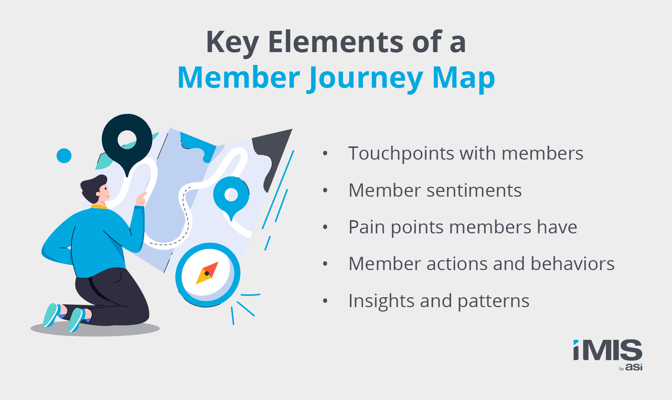What you may hear from members is often a symptom of several factors. It can fall under the category of disengagement, operational concerns, or even community culture issues. Here are 5 kinds of feedback from your members and what they may mean (as well as what you can do about it!):
“I didn’t know that was happening.”
It can be an awful feeling finding out you missed out. Whether it was an event they could have attended, an important deadline for feedback, or voting.
First, determine where the specific gap occurred. Then you can provide assurances to the member and establish process changes to prevent future lapses.
Review your communication channels to aim for multiple (but appropriate) reinforcements.
- A website update is often the first step. This is where you can keep all important information in one place as a centralized resource for members. Having a website that's easy to update is key to distributing information efficiently. Regular updates keep content fresh and help drive traffic to the website. Consider the different ways you can create an engaging web experience.
- Social media updates can also be a powerful way to reinforce website messaging in a bite-sized serving.
- You can even launch your own organization's private social media network with a dedicated mobile app. Learn how to launch a year-round mobile app with Clowder's best practice guide, Playbook: Launching Your Association's Mobile App. Give members a nudge with personalized push notifications.
- Email communications are a great way to keep in touch with members, but too many can be annoying and lead to being ignored. Consider using segmentation to differentiate between membership and marketing emails. There are also technical and compliance considerations if the member is opted into your Marketing emails to ensure deliverability.
- If your platform supports it, consider text message updates. These notifications are designed to be short and sweet. They're worth considering if the other channels have already been engaged with little response.
“It takes too long to get help.”
It can be jarring to hear a member isn’t getting the help they need. However, this may not necessarily mean your team is slow to respond by email or phone. Sometimes, the issue is less about actual wait times and more about the lack of clear self-help resources or guidance on where to go for support.

Start by acknowledging the member’s concern and asking for more detail. Their feedback can help you map out the support process, identify gaps, and determine whether a self-service option could reduce similar frustrations in the future.
One effective step is to document how members can get help, who to contact, and what response times they can expect. For example, you might clarify that phone calls are best for urgent issues, while emails are typically handled within a set timeframe. Setting clear expectations goes a long way in easing frustration.
You can also add context based on your organization’s size and capacity, since a one-person office looks different from a ten-person team.
And don’t overlook the value of a self-service portal. Many members prefer the speed and convenience of handling simple tasks on their own. Learn more about creating a member-friendly self-service portal.
“I don’t see the value in my membership.”
Hearing this can be discouraging, but it often signals a gap in how members are experiencing or perceiving the benefits of belonging to your organization. The key is to uncover the root cause and reconnect them to the value they may be missing.
Start by reviewing the member journey:
-
Map out the full experience: from acquisition and onboarding to engagement and renewal.
-
Look for friction points, bottlenecks, or any point where membership value isn’t clear.
-
Identify potential opportunities to reinforce the membership value.
- Consider automating parts of the journey to consistently highlight your value proposition.

See more in our article, How to Build an Effective Member Journey Map That Works
Reinforce value with tailored offerings:
Personalize engagement based on each member’s current activity or interests. Curate your existing resources so members see what’s most relevant to them. For example, if a member has a low engagement score, you may want the homepage of your member portal to show an introduction video. But a highly engaged member is likely ready to jump right into your benefits, so display a promo for your upcoming networking event.
Provide exclusive educational content, resources, or tools that aren’t freely available. Use a learning management system (LMS) to showcase courses or certifications that help members grow their skills. Other types of benefits include networking events, member-only directory, job boards, and advertising opportunities. It can be surprising how much underutilized resources can add to membership value.
Sometimes, members don’t need new benefits. They need help recognizing and using the ones already available to them.
Review your member value proposition
Follow our 6 steps to craft a compelling value proposition that showcases your association's unique benefits that members can’t live without.
- Assess Your Members’ Needs
- Clearly Define Your Target Member and Industry / Sector / Community
- Articulate the Pain Points They’re Facing
- Explain How Your Organization Understands and Addresses Their Issues
- Highlight What Makes You Unique
- Craft a Concise Statement That Embodies All the Above
More details on each of these steps in our article, How To Craft Your Association's Value Proposition
“I forgot to renew my membership.”
Forgetting to renew is one of the top 6 reasons memberships lapse (source: 2025 Membership Performance Benchmark Survey). But luckily, it's one of the easiest to prevent. With the right communication strategy, you can keep renewals on track while reinforcing the value of membership.
Set up automated reminders at key intervals (for example, 30 days before, one week before, on the expiration date, and a few days past due). Each reminder is a chance to highlight benefits and remind members of what they’d lose by letting their membership lapse.
Go beyond email when possible. A quick phone call, SMS, or even a push notification can add a personal touch—especially for high-value members. This is also a great opportunity to share new programs, perks, or upcoming events that make renewal feel like a no-brainer.
Finally, consider making renewal more convenient. Options like automatic renewal can reduce barriers, while incentives such as early renewal discounts, bonus perks, or even entry into a giveaway can motivate members to act quickly.
“It’s always the same people running everything.”
Hearing this may point less to leadership issues and more to a lack of visible engagement opportunities for members. It’s important to address the concern with transparency while also opening doors for broader involvement.
Start by clarifying how leadership roles are filled. Emphasize fairness and transparency in elections, appointments, or volunteer assignments so members understand the process.
At the same time, focus on creating more ways for members to get involved. Provide a central hub where members can connect and collaborate. Enable community-building features such as discussion boards, blogs, or online communities. A great hub for connection can be an online community or a year-round mobile app. The mobile experts at Clowder dive into the benefits of a year-round app in their article, How a Year-Round Membership App Delivers More Value Than Event Apps.
Even small opportunities for interaction can help members feel their voices matter and that leadership isn’t confined to the same group of people. Explore more on fostering member engagement and a sense of belonging with our article, How Community Engagement Boosts Association Member Retention.
